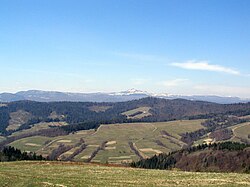Verecke Pass
| Veretsky Pass | |
|---|---|
| Верецький перевал | |
 Location of Veretsky Pass in Ukraine | |
| Traversed by | Road |
| Location | Ukraine |
| Range | Carpathians |
| Coordinates | 48°49′37.55″N 23°10′32.76″E / 48.8270972°N 23.1757667°E / 48.8270972; 23.1757667Coordinates: 48°49′37.55″N 23°10′32.76″E / 48.8270972°N 23.1757667°E / 48.8270972; 23.1757667 |

View from Verecke Pass

Memorial of the 1100th anniversary of the Hungarian conquest of the Carpathian Basin in 895 (photographed in 2008)

The river Stryi with Verets'ki pass.
Verecke Pass or Veretsky Pass (Ukrainian: Вере́цький перевал; transcribed: Veretskyy pereval, more formally: Ukrainian: перевал Середньоверецький, pereval Serednioveretskyy, also known as: Ukrainian: Ворі́тський перевал, transcribed: Vorítskyy pereval; Hungarian: Vereckei-hágó) is a mountain pass in Ukraine, one of the most important passes of the Inner Eastern Carpathian Mountains.
Contents
1 Location
2 History
3 References
4 External links
Location
The pass is located in the Carpathian Mountains just where the oblasts of Lviv and Transcarpathia meet, on the spine of the Northeastern Carpathians, between the Latorica or Latorytsia and Opir river valleys and at the river divide or watershed between the Latorytsia and the Stryi. It has an elevation of 841 meters.
History
The pass has been well-traveled for more than a millennium. In 895 the Hungarian tribes entered the Carpathian Basin and during the next century established the Kingdom of Hungary. In 1241 the main army of the Mongols crossed the pass into the Kingdom of Hungary. In 1703, when Francis Rákóczi II came back from exile at Berezhany Castle in present-day Ukraine, he traveled across Verecke Pass into the Hungarian Plain to assume leadership in an anti-Habsburg uprising which became known as Rákóczi's War of Independence.[1] In 1914 during the First World War the pass saw heavy fighting between Austrian-Hungarian troops and those of Tsarist Russia. During World War II the pass was the scene of further battles; the remains of the defensive fortifications of so-called the Árpád Line can still be seen today. Since 1980 the pass has been bypassed by major highways.
The pass is also memorable in Ukrainian history because in 1939, just before the outbreak of World War II, it was the site of a mass murder of some 600 Ukrainian partisans, the Carpathian Sich (Карпа́тська Січ, Karpatska Sich), who had been fighting against Hungarian and Polish forces.[2]
In 2008, the Hungarian government received permission from the Ukrainian government to install a monument to the passing of the Hungarian peoples into the future Hungary (in 895). The monument was designed by Hungarian sculptor Péter Matl (Петро Матл) who was born in Mukachevo.
References
^ Magocsi, Paul Robert: With Their Backs to the Mountains. A History of Carpathian Rus' and Carpatho-Rusyns. CEU Press, 2015
^ «Карпатська Січ» – без міфів і легенд ("The Carpathian Sich, Beyond Myths or Legends"), article from 04/04/2010 in the UA Reporter newspaper's on-line edition, accessed Nov. 13, 2010. (In Ukrainian).
External links
- See a photo and map at Panoramio.
| Wikimedia Commons has media related to Veretskyi Pass. |
This article about a location in Ukraine is a stub. You can help Wikipedia by expanding it. |